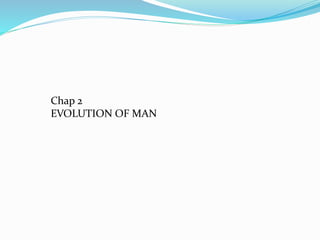
Chap 2 Evolution.pptx
- 1. Chap 2 EVOLUTION OF MAN
- 2. The Earth- Man’s Home Q1. how old is the earth believed to be? o{ The age of the Earth is now calculated to be around 4500 million years. oIt was hot in the beginning, but as time rolled by, the earth began to cool. o On cooling, lowlands got filled with water and turned to lakes, rivers, seas and further cooling led to formation of plains, hills, mountains and so on.} The earliest Life of Early Man Q2. Where did the earliest form of life start? •{ It is believed that the earliest form of life appeared near the water masses. •First some boneless creatures came into being. These developed into water animals like fish and crabs. •In the olden ages, the concept of Survival of the Fittest is very much applicable. Where the bigger and stronger feed on the Smaller and weaker ones. Eg dinosaurs. }
- 3. Man appears on the Earth •The ancestors of man appeared about 70 million years ago. •The closest relatives of man are believed to be the apes (like chimpanzees, Gorillas and orangutan). • The ape-man was a quadruped, who lived a wildlife. Similar to the wild animals. He moved on all four limbs. He hunted and gathered by day and live on trees and caves during the night to protect himself from other animals. •But over time, ultimately he was able to stand and walk upright. He now started using his forelimbs as hands also. In the later stage, his thumb could be placed opposite the fingers for a firm precision grip.
- 5. Q3. Describe briefly about the Old Stone Age. {The Old Stone Age The object used by early an was stone. They depended on stone for their survival. That is why this period is known as Stone Age. Having gained the ability so stand upright , he began to use his rain to solve day to day problems. Early man lived together in groups and were nomads. Early man was a Nomad. Who is a Nomad? : Someone who move constantly from one place to another in search for food, pasture lands and water. With stones, man invented stone weapons, as it was not safe for them. So they used these stone weapons to hunt food and also to protect themselves from wild and ferocious animals. The Old stone Age was also known as the Palaeolithic Age. It was said that the Palaeolithic age started about 2.6 million years ago. During the Old Palaeolithic age man made rough stone tools. On the bases of the changes in the shapes of stone tools, the Old Age is divided into: 1. Lower Palaeolithic Age 2. Middle Palaeolithic Age 3 . Upper Palaeolithic Age}
- 7. THE NEW STONE AGE The Upper Palaeolithic Age came to an end about the 8000 B.C The New Stone Age began in India around 6000 B.C. and lasted till 1000 B.C. This age marked the march of Man towards civilization. His ways of living too changed a lot during this period. Initially, man was a Nomad. He was a Hunter and Gatherer but during this Age he also started keeping animals, like the dog, sheep, cow, goat and horse. He wandered from place to place with his herd of cattle for food and fodder. Q4. Write a note on the Discovery of Fire by man. {The Discovery of Fire. •Initially, man did not know anything about the utility or how to use fire. He was afraid of Fire. •A sudden jungle Fire must have roasted some animals and man must have had a chance to eat them. •With his power of thinking, he new the art of feeding fire with dry leaves and twigs, to keep it alive. •One day, as he was chiselling or shaping his tools, sparks of fire were generated. So from this, man learned the art of making fire by striking two stones against each other. }
- 8. Q5. Write an note on the Metal Age and Stone Age. {METAL AGE •After man was able to identify metals, he invented the method of extracting metals from ores, to be used in the invention of metal tools and implements. •The period, where both copper and stone were used by man, is called the Chalcolithic Age. • Metals like tin and Zinc were also discovered. Man mixed these metals with copper to make bronze which is an alloy. •The Metal Age, thus, put an end to Stone Age. IRON AGE •The discovery of iron pushed man into the Iron Age. •The weapons and implements of iron were better than other Metals. •So man used iron extensively during this period. }
- 9. Q6. What is an Alloy? {A mixture or a combination of two or more metals is called an Alloy. An alloy is stronger and more durable when compared to a metal say Iron. An example of an Alloy: when tin, zinc and Copper are mixed together they form a new metal, called Bronze. Here, bronze is an alloy.}